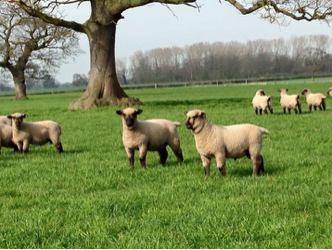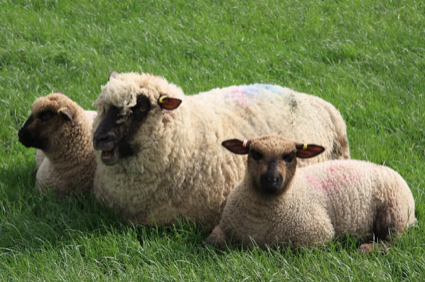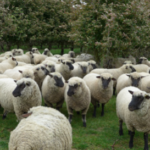Shropshire sheep are a Tri-purpose breed (meat, wool and tree-friendly) originally developed in the early 19th Century by farmers in Shropshire and the West Midlands. The Shropshire Sheep Breeders’ Association was formed in 1882 and has the distinction of being the oldest breed society in the UK.

The Rams are robust, will work early in the season and make good crossing sires. The Ewes are excellent mothers with long productive lives, also being able to naturally cycle early for lambs from December onwards. The Lambs are vigorous, grow fast and produce a good meaty carcass. They can finish from grass alone. Shropshires are also now well-known for being the “tree-friendly” breed. They are used widely to control grass and herbage in conifer plantations, orchards and other deciduous trees.
Flexibility for Flock-Owners
Shropshires are the most northerly of all the British “Downland” breeds. Shropshire sheep are hardy and versatile and thrive in a wide range of conditions, adapting to every soil and climate. They flourish throughout the British Isles, from the English lowlands to the highlands and islands of Scotland. Flocks are also kept successfully in the high rainfall areas of Ireland and at altitudes of more than 300 metres (1000 feet) in the mountainous areas of Wales.
Great Prolificacy and Longevity
Shropshires have the ability to lamb early. As dams, Shropshires are good mothers – being docile and milky, rearing twin lambs with ease. They are prolific and can achieve lambing percentages of 160% and above. They are extremely hardy and have a long productive flock life.
Easy Care and Thrifty
Shropshires are a relatively easy-care breed, being docile and easy to handle and requiring only minimal routine husbandry in most situations. The breed has a well-proven ability to finish successfully from grass alone.
Top Quality Shropshire Lamb
The Shropshire was originally developed as a supreme meat and wool breed, and today’s Shropshires retain the ability to produce finished lambs of the highest quality. The breed combines fast growth with excellent carcass traits. Modern Shropshires can be used pure for prime lamb production and the rams also make excellent terminal sires, when crossed with commercial ewes. For more details see our page
Breed Improvement Scheme

The Shropshire Sheep Breeders Association run a Breed Improvement Scheme in conjunction with Signet. This encourages breeders to measure performance traits of their sheep and lambs and so help to continually improve Shropshire ewes and rams characteristics as a meat producing and terminal sire breed. See the page for more details.
Excellent Scrapie Resistance
During the period of the National Scrapie Plan, nearly 4,500 Shropshires were scrapie genotyped. The breed was completely free from the “V” allele, which is linked to scrapie susceptibility. The National Scrapie Plan figures showed that around 60% of animals are Type 1 or Type 2 – the most resistant genotypes. Many Shropshire breeders have continued to scrapie genotype stock and the results continue to support the original analysis.
Shropshires Grazing in Trees
Shropshire sheep are now used widely throughout the UK and Europe to control grass and herbage in conifer plantations, orchards and amongst other deciduous trees. Apart from the advantage of reaping ”two crops from one acre”, in the modern world the reduction in the use of pesticides and herbicides and associated labour savings are a key benefit. Please see our page which includes details of a booklet produced by the breed society to help prospective keepers of sheep in trees.
Valuable Shropshire Wool
Shropshires produce high quality wool, suitable for hand knitting and a wide range of other uses. The sheep have a more complete covering of wool than any other Downland breed, and produce a heavy, dense fleece weighing between 2 and 3kg. The wool is described by the British Wool Marketing Board as “Fine with a pleasantly soft handle and almost free from kemp and grey and black fibres”. The staple length is typically between 10 to 15cm and Shropshire wool has a Bradford Quality Count of 54s to 56s.







